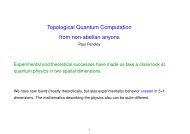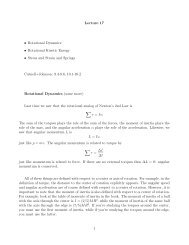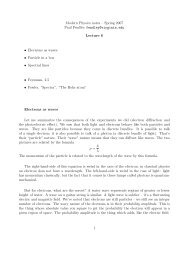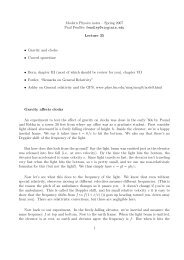Angular momentum and positronium decay - Paul Fendley
Angular momentum and positronium decay - Paul Fendley
Angular momentum and positronium decay - Paul Fendley
Create successful ePaper yourself
Turn your PDF publications into a flip-book with our unique Google optimized e-Paper software.
Modern Physics notes<br />
<strong>Paul</strong> <strong>Fendley</strong> fendley@virginia.edu<br />
Lecture 23<br />
• <strong>Angular</strong> <strong>momentum</strong> <strong>and</strong> <strong>positronium</strong> <strong>decay</strong><br />
• The EPR “paradox”<br />
• Feynman, 18.3, 11.4<br />
<strong>Angular</strong> <strong>momentum</strong> <strong>and</strong> <strong>positronium</strong> <strong>decay</strong><br />
Symmetry is of enormous importance in physics. When a system has symmetry, it leads to<br />
conservation laws: symmetry under time translation (i.e. the laws of physics are the same now<br />
as they were in 400 B.C.) results in energy conservation. Symmetry under spatial translation<br />
results in <strong>momentum</strong> conservation. Symmetry under rotations results in angular <strong>momentum</strong><br />
conservation.<br />
To underst<strong>and</strong> this in depth is beyond this course. But one can see some very simple consequences<br />
of how symmetry affects quantum mechanics (<strong>and</strong> hence the world!). I’ll explain how<br />
conservation of angular <strong>momentum</strong> helps us underst<strong>and</strong> the <strong>decay</strong> of a particle called “<strong>positronium</strong>”.<br />
Underst<strong>and</strong>ing this will lead to a seeming paradox, but whose resolution shows that<br />
quantum mechanics is correct <strong>and</strong> consistent, but very weird.<br />
Positronium is a bound state of an electron <strong>and</strong> a positron. A positron is an anti-electron: it<br />
has the electron mass, the same spin-1/2, but the opposite charge of an electron. (It therefore has<br />
positive charge, hence the name.) We haven’t talked about anti-particles much, <strong>and</strong> won’t have<br />
to say much more. Suffice to say that Dirac showed that in order to have a consistent theory of<br />
both quantum mechanics <strong>and</strong> special relativity, you must have antiparticles. Subsequently, the<br />
positron, anti-proton, etc., were observed. Since the photon is zero charge, it can be (<strong>and</strong> is) its<br />
own antiparticle. Thus the anti-photon is the same thing as a photon.<br />
We don’t see antiparticles very often, although they’re easy to make in high-speed particle<br />
collisions (the kind that happen in accelerators like Fermilab <strong>and</strong> JLab). The reason we don’t see<br />
them is that a particle <strong>and</strong> an anti-particle can annihilate each other. A particle <strong>and</strong> antiparticle<br />
together have no net charge, so it does not violate charge conservation for them to annihilate<br />
into photons (it needs to be more than one photon to conserve energy <strong>and</strong> <strong>momentum</strong>). When<br />
1
we do special relativity, we’ll see how one can underst<strong>and</strong> energy conservation in such <strong>decay</strong>s<br />
(advance preview: E = mc 2 ).<br />
Positronium is sort of like hydrogen, with the positron playing the role of the proton. But<br />
as opposed to hydrogen, the positron is not stable: after about 10 −10 seconds, the positron<br />
<strong>and</strong> electron annihilate into photons. Thus we say that <strong>positronium</strong> <strong>decay</strong>s, like a radioactive<br />
nucleus.<br />
But now here’s the interesting part. Let’s look at the spin of <strong>positronium</strong>. The electron <strong>and</strong><br />
positron each can have S z = /2 or S z = −/2. There are therefore four possible states for the<br />
spins of an electron <strong>and</strong> a positron:<br />
| ↑↑〉, | ↑↓〉, | ↓↑〉, | ↓↓〉<br />
Remember that although we can not in general know all the components of the spin at one time,<br />
we can know both S z <strong>and</strong> ⃗ S · ⃗S. To get the total S z , you just add the S z of each. The four<br />
possible spin states of <strong>positronium</strong> therefore have S z = , 0, 0, <strong>and</strong> − respectively.<br />
Finding ⃗ S · ⃗S for <strong>positronium</strong> is trickier. Remember that a particle is of spin-s when ⃗ S · ⃗S =<br />
s(s + 1) 2 . For example, for a spin-1/2 particle, ⃗ S · ⃗ S = 3 2 /4: this is easy to check by<br />
remembering that always S x = ±/2, S y = ±/2 <strong>and</strong> S z = ±/2. This means that always<br />
(S x ) 2 = 2 /4, (S y ) 2 = 2 /4 <strong>and</strong> (S z ) 2 = 2 /4, so that ⃗ S · ⃗S = 3 2 /4 as claimed. For general spin<br />
s, S z can have the quantized values<br />
S z = −s, (−s + 1), . . . , (s − 1), s<br />
This means there are (2s + 1) possible spin states of a spin-s particle.<br />
There are four possible spin states of <strong>positronium</strong>. Thus you might guess that <strong>positronium</strong><br />
is of spin 3/2. However, this can’t be: the four possible S z values of a spin 3/2 particle are<br />
−3/2, −/2, /2, 3/2, while the four S z values of <strong>positronium</strong> are S z = −, 0, 0, . Thus<br />
what happens is that there are two possible spin values for <strong>positronium</strong>. A <strong>positronium</strong> particle<br />
can either have spin 1 (<strong>and</strong> so S z = , 0, −) or spin 0 (<strong>and</strong> so S z = 0). This is possible because<br />
<strong>positronium</strong> is a bound state of fundamental particles.<br />
This explanation leaves one question still open. Of the two states with S z = 0, which has<br />
⃗S · ⃗S = 0, <strong>and</strong> which has ⃗ S · ⃗S = 2 2 ? On your homework, you’ll check that the state<br />
is the one with ⃗ S ⃗ S = 0.<br />
1<br />
√ | ↑↓〉 − √ 1 | ↓↑〉<br />
2 2<br />
We need to know one more thing about spin before underst<strong>and</strong>ing <strong>positronium</strong> <strong>decay</strong>. Photons<br />
have spin 1. Let the z axis be the direction the photons is moving (remember light is never<br />
2
at rest, so there always is a well-defined z axis for a photon.) When S z = for a photon, we<br />
say the photon is right-circularly polarized. Classically, this means that the electric field vector<br />
is rotating clockwise, hence the name. When S z = −, it is left-circularly polarized. You may<br />
recall that light cannot be longitudinally-polarized: this means that the electric <strong>and</strong> magnetic<br />
fields always point perpendicular to the direction of motion. The quantum-mechanical version<br />
of this statement is that S z cannot be zero for a photon, it can only be S z = ±.<br />
Finally, we can underst<strong>and</strong> the <strong>decay</strong> of <strong>positronium</strong>. Let’s consider the possible <strong>decay</strong>:<br />
<strong>positronium</strong> with S ⃗ · ⃗S = 2 2 (i.e. spin 1) at rest <strong>decay</strong>ing into two photons. By <strong>momentum</strong><br />
conservation, the two photons head off in opposite directions. Because angular <strong>momentum</strong><br />
is conserved in the <strong>decay</strong> (remember that spin is just intrinsic angular <strong>momentum</strong>!), the two<br />
photons after the <strong>decay</strong> must have the same S z as the <strong>positronium</strong> did before the <strong>decay</strong>. Two<br />
photons heading in opposite directions have four possible spin states<br />
|RR〉, |RL〉, |LR〉, |LL〉<br />
(there would be nine if longitudinally-polarized S z = 0 photons existed). These four states have<br />
possible S z = 0, 2, −2 <strong>and</strong> 0. (Note that S z = 0 for |RR〉: the z axis for a given photon is its<br />
direction of motion, <strong>and</strong> the two photons are moving in opposite directions.) Thus <strong>positronium</strong><br />
with S z = or S z = − cannot <strong>decay</strong> into two photons. In fact, a state with ⃗ S · ⃗S = 2 2 cannot<br />
ever <strong>decay</strong> into two photons, even if the overall S z = 0. The reason comes from the fact that<br />
photons are bosons. When you rotate the system by 180 degrees, the two photons just change<br />
places. Since they are identical (both have S z = 0) bosons, the probability amplitude must<br />
be the sum of the two possibilities. However, you can show (using some rules slightly beyond<br />
the scope of this course, but they’re in Feynman, chapter 17) that if you rotate a state with<br />
⃗S · ⃗S = 2 2 <strong>and</strong> S z = 0 by 180 degrees, you pick up a minus sign. This means that the two<br />
amplitudes have opposite sign. When you add the two, you get zero!<br />
Therefore a spin-1 <strong>positronium</strong> particle cannot <strong>decay</strong> into two photons. This is an example of<br />
how powerful symmetry can be in physics. It means that it can only <strong>decay</strong> into 3 photons, <strong>and</strong> it<br />
turns out that the amplitude for this to happen is much smaller than that for two-photon <strong>decay</strong><br />
(to compute this requires quantum field theory, a topic that unfortunately even many graduate<br />
students in physics don’t bother with). Thus the symmetry means that spin-1 <strong>positronium</strong> is<br />
much longer-lived than spin-0 <strong>positronium</strong>. Its half-life is about 10 −7 seconds, instead of 10 −10<br />
seconds.<br />
Positronium with spin 0 (which requires S z = 0) does <strong>decay</strong> into two photons. The final state<br />
must have all components S x = S y = S z = 0. The photons must therefore be in the state<br />
1<br />
√ |RR〉 − √ 1 |LL〉<br />
2 2<br />
just like a ⃗ S · ⃗S state of two spin 1/2 particles 1 √<br />
2<br />
(| ↑↓〉 − | ↓↑〉).<br />
3











